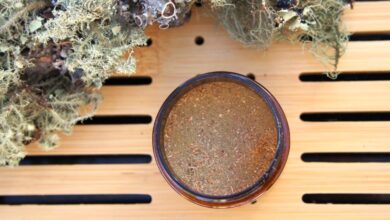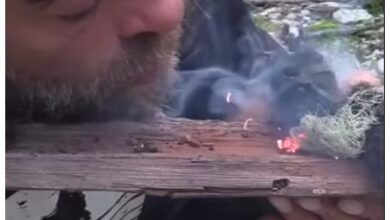Perilla Mint: Identification and Foraging Guide

Love eating weeds?
Add perilla to the list!
This cheeky member of the mint family is grown as a culinary and medicinal herb across Asia. Once it arrived in the US, it quickly became an out-of-control invasive species with a terrible reputation.
While the reputation is somewhat warranted (perilla is poisonous to livestock), the plant is safe for people to consume and downright delicious when prepared properly.
Because it is so prolific, it provides an amazingly abundant food resource for homesteaders to snack on or preserve for the winter months. It also has a ton of practical medicinal benefits.
Ready to dive in? Read on to learn how to identify perilla and “weed” out the lookalikes!
Taxonomy And Characteristics
Perilla is known by numerous names depending on location. You may hear it referred to as shiso, beefsteak plant, wild basil, Chinese basil, wild coleus, purple mint, or a variety of other monikers.
People call perilla “rattlesnake weed” in my neck of the woods. Once the plant matures and the seeds dry on their pods, they make a conspicuous rattling sound when shaken. It’s enough to scare even a seasoned forager off the path!
There are numerous perilla species taxonomically, and many are named differently in various locations. However, all are woody, herbaceous annuals.
Here in the US, there are two types you’ll run into while foraging: green and purple. Green is likely the cultivar Perilla frutescens, while red is likely Perilla frutescens var. crispa. They look alike except for the color difference.
- Leaves: Leaves are oval with serrated edges and grow up to four inches long. They are petiolate and grooved in the center, appearing in opposites like many other members of the mint family.
Leaves will be green, red, purple, or a combination of these colors. The tops may be colored differently from the undersides, with green showing from above and purple from below. Undersides may have short hairs, while tops rarely do.
- Stalk: Stalks usually grow two to three feet but can reach five or six feet under optimal conditions. They may be smooth or covered in fine hairs. Stalk coloring is green or purple, with stalks being squarish and hollow when cut.
- Flowers: Late in the season, perilla mint sprouts flower stalks (racemes) at its crown or along the central stalk. These usually grow between three and six inches long. Flowers bloom along the raceme and may be white or purple. Each flower is just a few millimeters long.
If unsure whether your find is perilla, crush a leaf beneath your fingers and inhale the scent. Perilla is a delicious edible with a minty, herby smell. It has hints of spice, earthiness, and sweet anise.
Season And Growth Habits
When It Grows
Perilla mint is a warm-weather herb that sprouts in early to mid-summer. By late summer, it reaches maturity and should be flowering. The timing will differ depending on where you live because of varying temperatures. Still, its life cycle usually runs somewhere between May and October.
After the season ends, you will often see dried-up stalks of perilla left behind. These may or may not persist through the winter, but pay attention to where they are. This is likely where your perilla will be growing next year!
Where It Grows
Perilla favors semi-shaded areas with plenty of moisture. It is common in dry to damp creek bottoms, low pastureland, forest understories, trails, roadside ditches, and pastureland.
You’ll often see it creeping along fence lines, barns, or areas with disturbed soil. I could go on, but the truth is that perilla is exceptionally adaptable. You can usually find it growing anywhere seeds have spread.
Seeds generally spread far and wide since each plant can produce up to 1,500. The seeds remain viable for quite a while and have a reported germination rate of over 60% after four years at room temperature.
Even though perilla will grow to its healthiest with plenty of water, it is very hardy. It will still grow — albeit stubbier — during droughts. When the season is particularly dry, you can often still forage perilla even if other plants are withering.
Lookalikes to Watch Out For
Perilla looks similar to other members of the mint family, like spearmint and purple dead nettle. Fortunately, its more extensive bushy growth and unique leaf coloring make it easy to distinguish.
While perilla doesn’t have that many true wild lookalikes, hophornbeam copperleaf could trip you up as a beginner.
Hophornbeam Copperleaf
Unlike perilla, hophornbeam copperleaf is a North American native. It is known scientifically as Acalypha ostryifolia and is not a mint but classified as a spurge.
However, it does look quite a bit like perilla. With serrated leaves and similar flower racemes, the two are easy to mistake — especially since hophornbeam copperleaf is a late bloomer that shows up at the same times and places you may find perilla.
You can usually differentiate them by smell, size, and color. The hops do not have the characteristic minty smell of perilla, they won’t get as big, and they do not have the purple tinge that perilla is so famous for.
Another way to tell them apart is by their leaf shape. Hophornbeam leaves tend to bend down and curl more than shiso, resembling kitchen basil.
A word of warning, however — while the name “hophornbeam copperleaf” might be a mouthful, this is one plant you should keep your tongue away from. It is mildly toxic to humans when consumed.
Ready to chow down? Hit the trail to forage perilla today. The culinary possibilities are endless, and you’ll do your part to help control an invasive species — a real win-win!
Read the full article here






